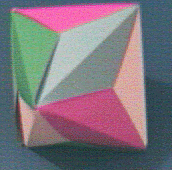 Octahedron-Tri
Octahedron-Tri Octahedron-Tri
Octahedron-Tri
Construction paper - preferably sulfide, 12"x18". Fadeless paper will keep its color longer.
Pattern. A pattern consisting of seven quadrilaterals in a strip; this pattern can be downloaded.

Scissors
Cardboard backing
Push pins
Sharp table edge
Paper clips
Schlafli symbol: 3.3.3.3
Type of plait: triangular
Plaiting pattern: Crystal (4 strips each 6 quadrilaterals long)
Complexity: 24 (about 12 minutes)
The octahedron appears in a number of crystals and can be described as two Egyptian pyramids fastened together at the base. It is the shape that gives meaning to "diamond" as a lozenge- shape. It consists of eight triangles with four meeting at each vertex.
There is one pattern piece for this model. The model requires four of these pieces, which should be 7 quadrilaterals long, 6 plus one for the tuck-in piece. The best color scheme is four different colors. The two end quadrilaterals are tabs - they tuck under a quadrilateral from another strip.
This solid is attractive but the octahedron shape is hard to bring about because the edges occur in the middle of the quadrilaterals so that only a fold marks the edges. For this reason the folds need to be sharp and well defined for this solid.
1. Cut out the pieces
Lay the backing on a table. The purpose of this backing is to absorb the pricks from the push pin. Lay the required number of sheets of construction paper on the backing, one on top of the other. Lay the pattern on top of the construction paper stack.
Prick each corner of the pattern with the pin hard enough to go through all the pieces of construction paper.
Using the pricks as a guide, cut the pieces out from the construction paper. First cut around the pricks so that you don't have to deal with the entire sheet of construction paper. Cut from prick to prick. Using a straightedge to draw lines between pricks to determine where the cut should go will result in a more accurate cut but will also result in a pencil mark to erase.
Several sheets can be cut at the same time. Staple the sheets together, being generous with the staples. Be careful that the sheets don't wander when you cut them - that could result in inaccurately cut pieces.
2. Fold the pieces
Lay the pattern on a table. Lay a piece next to it so that it is oriented the same as the table pattern. Fold on the inside according to the solid lines in the pattern. Use a sharp table edge or ruler edge to make a clean fold. The folds should cause the strip to curve upward.
Fold each strip the same way. Folding two or three at once will save time but may result in inaccurate folds. Folding the strips so that they are oriented the same as the table pattern will ensure that the strips will fold together so that the tabs will tuck under, not over.
3. Assembling the model
This model is formed by weaving the strips together. A strip goes over another strip and then under the next one, continuing the under and over pattern around the model.
Two strips overlap at a quadrilateral, a polygon with four sides. Such a polygon has two pairs of opposing edges. One strip goes over one pair of opposing edges, and the other strip over the other pair.
Therefore, the quadrilaterals on each strip alternates between under and over. Laid out flat, the strip looks like this:
under, over, under, over, under, over, under
The tabs tuck under a quadrilateral from another strip, a little like closing the cover on a cardboard box. So when assembling the solid, make sure that the tabs go under. When introducing a new strip, count from the crossing point to the end. If the strip is inserted under another one, for example, count "under, over, under." until you reach the end. If you get "over" when you reach the end, the strip is inserted incorrectly.
The weaving operation leaves a result consisting only of the strips of construction paper, but paper clips are needed to form the model. The paper clips are removed when the model is completed.
a. Fasten two strips together. Align two strips so that they overlap at a quadrilateral, which in this solid is skew and consists of two obtuse triangles connected at a fold that marks the edge of the solid. Count to the end of the strip as above to make sure the strips are correctly aligned. One way of aligning them correctly is to place the fourth quadrilateral of one strip over the third quadrilateral of another one.
b. Insert a third strip so it overlaps both the other ones at quadrilaterals, so that the strips alternate between over and under. This will complete a triangular face.
c. Add the fourth strip and weave until the solid is complete. Weave strips under and over and under other strips. Use paper clips to hold the weaves together and take them out after they are not needed to hold the solid together. Ensure that there are four triangular faces at each corner, as four triangles meet at every vertex of an octahedron.
The model is apt to look like a confusing melange of paper strips, and one gets a feeling of completeness and accomplishment as these strips slowly come together to form the solid. A final tuck of one strip under another completes the model.